Amazon puffers are adorable, but even the cutest of fish can benefit from some company. The question is, what fish make the best amazon puffer tank mates?
The best amazon puffer tank mates are the fish that can survive in similar circumstances, such as temperature and hardness of water, to the amazon puffer. They should also be compatible in terms of temperament so that the fish do not stress one another unnecessarily, and do not over-compete for food.
In this article we’ll take a look at all the suitable tank mates for an Amazon Puffer. We will examine each one in detail to see facts about the type of fish they are, as well as what makes them work so well with the Amazon Puffer. With so much to cover, let’s get started.
Contents
Amazon Puffer Tank Mates – What You Need to Know
Everyone knows owning a pet is a big responsibility, and between different environmental and dietary needs, owning a fish is no different. That being said, adding more fish to a tank can triple those responsibilities! Let’s look at some things to keep in mind about how to care for both an amazon puffer and it’s tank mates.
Temperament
Temperaments are some of the most important things to consider when one fish is about to live in the same space as another. If your puffer feels constantly threatened by the natural behavior of a tank mate, it could lead to disaster in the tank.
Thankfully, amazon puffers make this a little easier with their peaceful temperament. While these fish can show some territorial tendencies, they are actually one of the friendliest fish among puffer fish species.
This means that any fish you get needs to be either another amazon puffer, or similarly peaceful in temperament. The best fish has just enough gumption to hold it’s own if the amazon puffer is feeling feisty, but won’t go looking for a fight.
Size
Amazon puffers are 3 inches long, in total. This is another trait that makes them, out of most other puffers, easy to keep in a community tank. Amazon puffers are little, but that doesn’t mean they can’t be dangerous to other fish.
If you have fish which are too small, such as 1 inch or less, they could wind up being mistaken for prey by even the friendliest of amazon puffers. Aim for fish of the same size, or just an inch or two larger, than the amazon puffer for the best results.
Competition
Food competition can occur between any members of a species. When it comes to amazon puffers, it is important to get fish which do not eat the same diet. Even if they do enjoy some of the same plants and meats that the puffer likes, try to be sure they don’t need to eat as much or as often, or even in the same zones of the tank.
This will cut down on food competition and ensure that every fish gets enough to eat.
Parameters & Tank Setup
Amazon puffers need water temperatures of 72 through to 82 degrees Fahrenheit. As you can probably see, this large range of temperatures shows off how hardy the amazon puffer really is. It is able to withstand lots of different environments in the wild!
A tank size of at least 55 gallons is ideal. This way, there is room for plenty of plants to interact with, but also enough space for these active fish to enjoy themselves!
Any tank mates you pick out should have similar likes, dislikes, and needs as the amazon puffer.
Best Amazon Puffer Tank Mates
- Siamese Algae Eater
- Bronze corydoras
- Panda Cory
- Pygmy Cory
- Bandit Cory
- Kuhli Loach
- Dwarf Armored Catfish
Let’s take a closer look at all of the above-listed fish to see why they get along so well with the amazon puffer.
You will also like these other popular posts in this category:
1. Siamese Algae Eater

- Scientific Name: Crossocheilus oblongus
- Adult Size: 6 inches
- Compatible With: Amazon Puffer Fish
- Care Level: Easy
- Origin: Thailand, Malaysia, Southeast Asea
The Siamese Algae Eater is a wonder to have in the tank. This long-bodied freshwater fish will be perfectly happy chowing down on the algae that accumulates on anything in your tank, saving you cleaning time!
It will cause absolutely no trouble for the smaller amazon puffer because it is a gentle giant at heart. The Siamese Algae Eater lives for around ten years, and has a sharp-looking set of features. It typically looks either gray or gold depending on how the light hits it. This is accented by a jet-black stripe running horizontally down it’s body.
Pros of keeping with Amazon Puffer:
- No aggression
- Cleans up the bottom of the tank
- No food competition
Cons of keeping with Amazon Puffer :
- None
2. Bronze corydoras
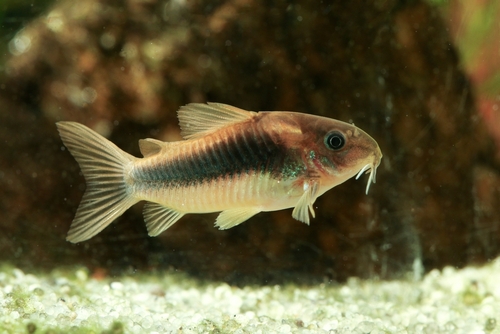
- Scientific Name: Corydoras Aeneus
- Adult Size: 2 inches
- Compatible With: Amazon Puffer Fish
- Care Level: Easy
- Origin: Colombia, Argentina, Venezuela
The bronze corydoras is a fantastic choice of tank mate for several reasons. For one, this fish is another like the Siamese Algae Eater which will spend all of it’s time around the bottom of the tank, cleaning up detritus for you.
For another, bronze corys are delightful to look at. They have also been called green or emerald corys thanks to the greenish tint their otherwise plain brown bodies have. They also have adorable whiskers and alert-looking eyes.
Bronze corys are so content to eat at the bottom of the tank that they will not only cause no food competition for your amazon puffer, but they won’t be aggressive, either.
Pros of keeping with Amazon Puffer:
- No aggression
- Cleans up bottom of the tank
- No food competition
Cons of keeping with Amazon Puffer :
- None
3. Panda Cory
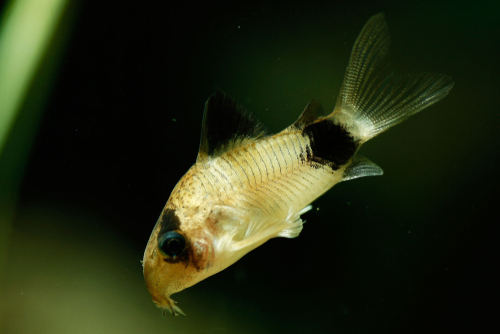
- Scientific Name: Corydoras panda
- Adult Size: 2 inches
- Compatible With: Amazon Puffer Fish
- Care Level: Easy
- Origin: Ucayali river system in Peru
The panda cory is a type of cory that is only found, so far, in one area of the world. This makes it a little on the rare side for aquarium hobbyists; however, it is well worth looking into as a tank mate for your amazon puffer!
This is because the panda cory likes company and is very peaceful. In the wild, it likes to school with its own kind, and since it is on the smaller side, why not get more than one? The panda cory is not only peaceful, but is another bottom-dwelling fish that will not attempt to cause an issue when it comes to food competition for your amazon puffer.
Panda cories are named for their black and white colors. They do still have the cute whiskers of their species and a slightly longer-than-average tail, too!
Pros of keeping with Amazon Puffer:
- No aggression
- No food competition
- Cleans up bottom of the tank
Cons of keeping with Amazon Puffer :
- None
4. Pygmy Cory
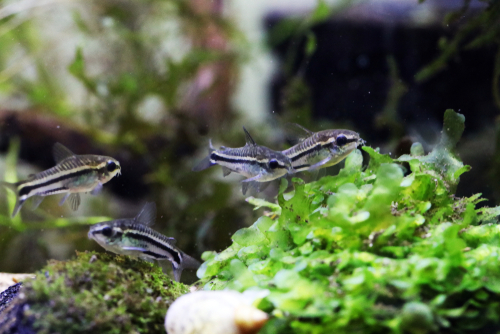
- Scientific Name: Corydoras pygmaeus
- Adult Size: 1 inch
- Compatible With: Amazon Puffer Fish
- Care Level: Easy
- Origin: South America
Pygmy cories are worth getting for sheer cuteness, alone. That said, you may be wondering what the smallest cory fish known to man is doing on a list for tank mates for a puffer three times it’s size.
Well, it is true that the size of a pygmy cory might pose a problem with an amazon puffer, who could mistake a tank mate for a snack. However, this problem disappears as long as you have more than one pygmy cory. There is strength and confidence in numbers for this schooling fish!
Pygmy corys prefer the bottom, where they will not out-compete your puffer for food. Pygmy corys are small, gray and silver, with a set of white and black interlocking stripes!
Pros of keeping with Amazon Puffer:
- No aggression
- No food competition
- Cleans up bottom of the tank
Cons of keeping with Amazon Puffer :
- Could be eaten without 4 or more of it’s own kind
5. Bandit Cory
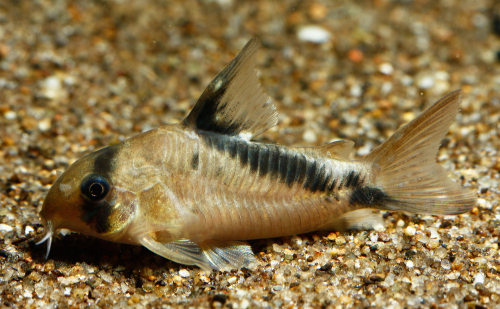
- Scientific Name: Corydoras metae
- Adult Size: 2 inches
- Compatible With: Amazon Puffer Fish
- Care Level: Easy
- Origin: Colombia
The Bandit cory might, at first glance, look a lot like our previously-mentioned panda cory. It is also black and white and on the smaller size for a cory; however, the Bandit cory comes from a different part of the world and is not quite as social as the panda cory.
It is known as the masked cory or bandit cory for the black or gray stripe that scores across it’s eyes like a cartoon burglar’s mask! The bandit cory is peaceful and will cause no trouble for your amazon puffer.
Pros of keeping with Amazon Puffer:
- No aggression
- No food competition
- Cleans up bottom of the tank
Cons of keeping with Amazon Puffer :
- None
6. Kuhli Loach

- Scientific Name: Pangio kuhlii
- Adult Size: 4 inches
- Compatible With: Amazon Puffer Fish
- Care Level: Easy
- Origin: Malay Peninsula, Indonesia
Everyone who has a community tank loves the kuhli loach! This is because they are not only easy to take care of, hardy, and well-suited to living with others due to their peaceful nature; kuhli loaches are also cool to look at.
They may not fit the description of a fish with their long, rope-like yellow and brown-spotted bodies, but that is what a kuhli loach is, we assure you! With enough room for this long fish to spread out, you’ll be pleased to see that it stays near the bottom of the tank and coexists nicely with amazon puffers.
Pros of keeping with Amazon Puffer:
- No aggression
- No food competition
- Cleans up bottom of the tank
Cons of keeping with Amazon Puffer :
- None
7. Otocinclus catfish
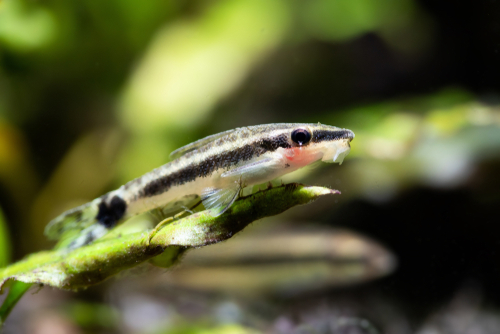
- Scientific Name: Otocinclus sp.
- Adult Size: 2 inches
- Compatible With: Amazon Puffer Fish
- Care Level: Easy
- Origin: South America
The otocinclus (dwarf armored catfish) goes by a surplus of names: oto, dwarf sucker, oto cat, and even plain old “otto!” Regardless of what you choose to call your otocinclus, your amazon puffer will be safe calling it a tank mate.
The otocinclus is another very peaceful bottom-dweller. It will be just as happy to cruise along the bottom of the tank alone as your amazon puffer is to race around the tank with friends.
In the meantime, as usual, the otocinclus catfish will clean up the bottom of the tank, eat algae, and won’t to steal any of the amazon puffer’s food. It has a delightfully flat, aerodynamic head which is brown with speckles divided from a white tummy by a black and white stripe.
Pros of keeping with Amazon Puffer:
- No aggression
- No food competition
- Cleans up the bottom of the tank
Cons of keeping with Amazon Puffer :
- None
In Conclusion
To sum it all up, the amazon puffer tank mates that will work best will be able to survive in the same type of tank conditions. They will also not out-compete the puffer for food, and will be peaceful in nature. With fish like the kuhli loach or the bandit cory, you’ll have a delightful community of fish!

JJ has had a passion for learning about aquatic life since age 5. As an adult, he made his passion a career as a certified aquaculture dealer and aquarium content creator.


